engine TOYOTA CAMRY 2015 XV50 / 9.G Quick Reference Guide
[x] Cancel search | Manufacturer: TOYOTA, Model Year: 2015, Model line: CAMRY, Model: TOYOTA CAMRY 2015 XV50 / 9.GPages: 23, PDF Size: 1.5 MB
Page 2 of 23
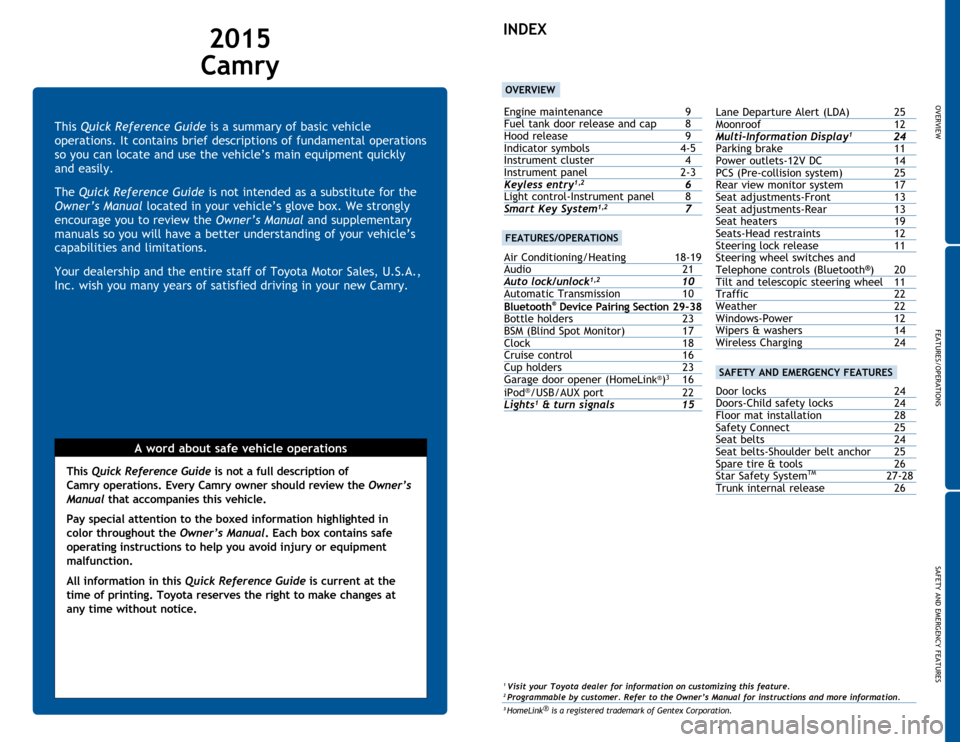
OVERVIEW
FEATURES/OPERATIONS
SAFETY AND EMERGENCY FEATURES
1
This Quick Reference Guide is a summary of basic vehicle
operations. It contains brief descriptions of fundamental operations
so you can locate and use the vehicle’s main equipment quickly
and easily.
The Quick Reference Guide is not intended as a substitute for the
Owner’s Manual located in your vehicle’s glove box. We strongly
encourage you to review the Owner’s Manual and supplementary
manuals so you will have a better understanding of your vehicle’s
capabilities and limitations.
Your dealership and the entire staff of Toyota Motor Sales, U.S.A.,
Inc. wish you many years of satisfied driving in your new Camry.
A word about safe vehicle operations
This Quick Reference Guide is not a full description of
Camry operations. Every Camry owner should review the Owner’s
Manual that accompanies this vehicle.
Pay special attention to the boxed
information highlighted in
color throughout the Owner’s Manual. Each box contains safe
operating instructions to help you avoid injury or equipment
malfunction.
All information in this Quick Reference Guide is current at the
time of printing. Toyota reserves the right to make changes at
any time without notice.
2015
Camry
INDEX
1 Visit your Toyota dealer for information on customizing this feature.2 Programmable by customer. Refer to the Owner’s Manual for instructions and more information.3 HomeLink ®
is a registered trademark of Gentex Corporation.
OVERVIEW
FEATURES/OPERATIONS
Lane Departure Alert (LDA) 25
Moonroof 12
Multi-Information Display1 24
Parking
brake
11
Power outlets-12V
DC
14
PCS (Pre-collision system)
25
Rear
view monitor system
17
Seat
adjustments-Front
13
Seat
adjustments-Rear
13
Seat
heaters
19
Seats-Head
restraints
12
Steering
lock release
11
Steering
wheel switches and
Telephone
controls (Bluetooth
®) 20
Tilt and
telescopic steering wheel 11
Traffic
22
Weather
22
Windows-Power
12
Wipers & washers
14
Wireless
Charging
24
Door locks 24
Doors-Child safety locks 24
Floor
mat installation
28
Safety
Connect
25
Seat
belts
24
Seat
belts-Shoulder belt anchor
25
Spare
tire & tools
26
Star
Safety System
TM 27-28
Trunk
internal release 26
Engine maintenance 9
Fuel tank door release and cap 8
Hood release
9
Indicator symbols
4-5
Instrument cluster
4
Instrument panel
2-3Keyless entry1,2 6
Light control-Instrument panel 8
Smart Key System1,2 7
Air Conditioning/Heating
18-19
Audio
21
Auto lock/unlock
1,2 10
Automatic
Transmission 10
Bluetooth® Device Pairing Section 29-38
Bottle
holders 23
BSM
(Blind Spot Monitor)
17
Clock
18
Cruise control
16
Cup
holders
23
Garage
door opener (HomeLin
k®)3 16
iPod®/USB/AUX port 22
Lights1 & turn signals 15
SAFETY AND EMERGENCY FEATURES
Page 3 of 23
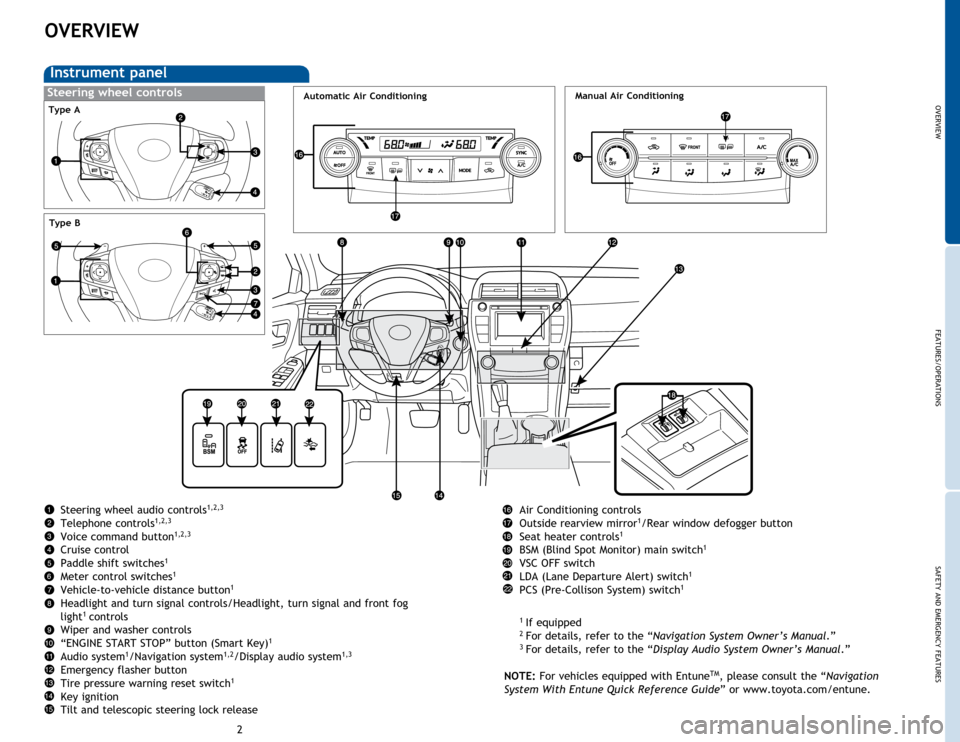
OVERVIEW
FEATURES/OPERATIONS
SAFETY AND EMERGENCY FEATURES
23
OVERVIEW
Instrument panel
Steering wheel audio controls1,2,3
Telephone controls1,2,3
Voice command button1,2,3
Cruise control
Paddle shift switches1
Meter control switches1
Vehicle-to-vehicle distance button1
Headlight and turn signal controls/Headlight, turn signal and front fog
light1 controls
Wiper and washer controls
“ENGINE START STOP” button (Smart Key)
1
Audio system1/Navigation system1,2/Display audio system1,3
Emergency flasher button
Tire pressure warning reset switch1
Key ignition
Tilt and telescopic steering lock release Air Conditioning controls
Outside rearview mirror
1/Rear window defogger button
Seat heater controls1
BSM (Blind Spot Monitor) main switch1
VSC OFF switch
LDA (Lane Departure Alert) switch1
PCS (Pre-Collison System) switch1
1
If equipped2 For details, refer to the “Navigation System Owner’s Manual.”3 For details, refer to the “Display Audio System Owner’s Manual .”
NOTE: For vehicles equipped with Entune
TM, please consult the “Navigation
System With Entune Quick Reference Guide” or www.toyota.com/entune.
Steering wheel controlsAutomatic Air ConditioningManual Air Conditioning
Type A
Type B
Page 4 of 23
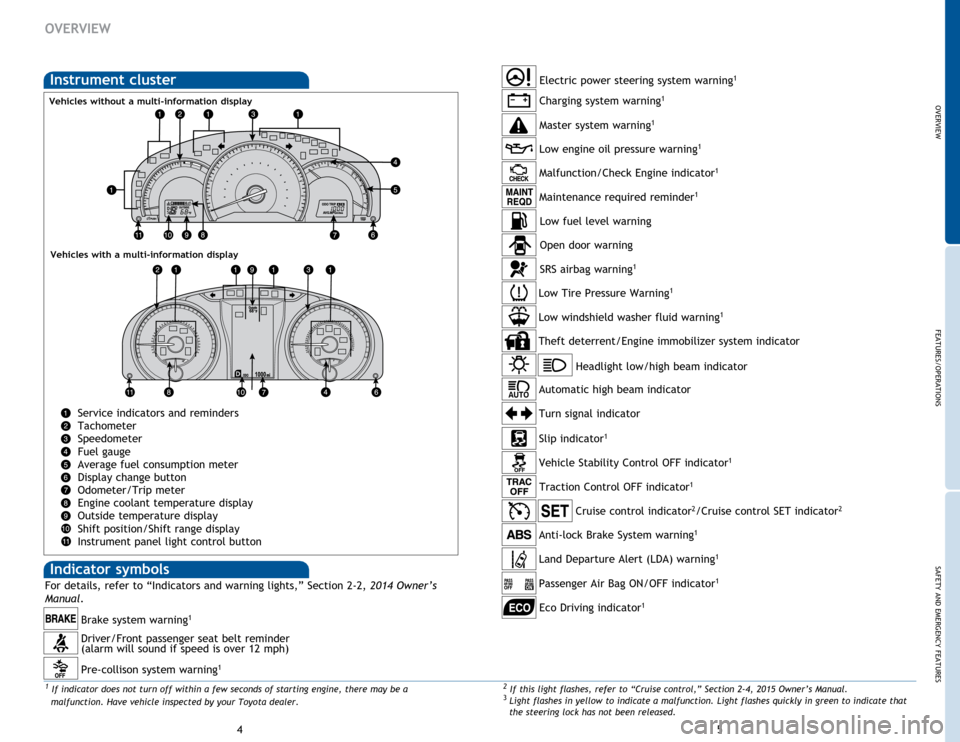
OVERVIEW
FEATURES/OPERATIONS
SAFETY AND EMERGENCY FEATURES
45
OVERVIEW
Instrument cluster
Service indicators and reminders
Tachometer
Speedometer
Fuel gauge
Average fuel consumption meter
Display change button
Odometer/Trip meter
Engine coolant temperature display
Outside temperature display
Shift position/Shift range display
Instrument panel light control button
Charging system warning1
2 If this light flashes, refer to “Cruise control,” Section 2-4, 2015 Owner’s Manual.3 Light flashes in yellow to indicate a malfunction. Light flashes quickly in green to indicate that
the steering lock has not been released.
Headlight low/high beam indicator
Turn signal indicator
Slip indicator
1
Cruise control indicator2/Cruise control SET indicator2
Low Tire Pressure Warning1
Theft deterrent/Engine immobilizer system indicator
Open door warning
SRS airbag warning1
Low windshield washer fluid warning1
Electric power steering system warning1
Low engine oil pressure warning1
Malfunction/Check Engine indicator1
Maintenance required reminder1
Low fuel level warning
Driver/Front passenger seat belt reminder
(alarm will sound if speed is over 12 mph)
Vehicles without a multi-information display Vehicles with a multi-information display
Anti-lock Brake System warning1
Indicator symbols
Brake system warning1
For details, refer to “Indicators and warning lights,” Section 2-2, 2014 Owner’s
Manual .
1 If indicator does not turn off within a few seconds of starting engine, there may be a
malfunction. Have vehicle inspected by your Toyota dealer.
Traction Control OFF indicator1
Vehicle Stability Control OFF indicator1
Eco Driving indicator1
Pre-collison system warning1
Master system warning1
Automatic high beam indicator
Land Departure Alert (LDA) warning1
Passenger Air Bag ON/OFF indicator1
Page 5 of 23
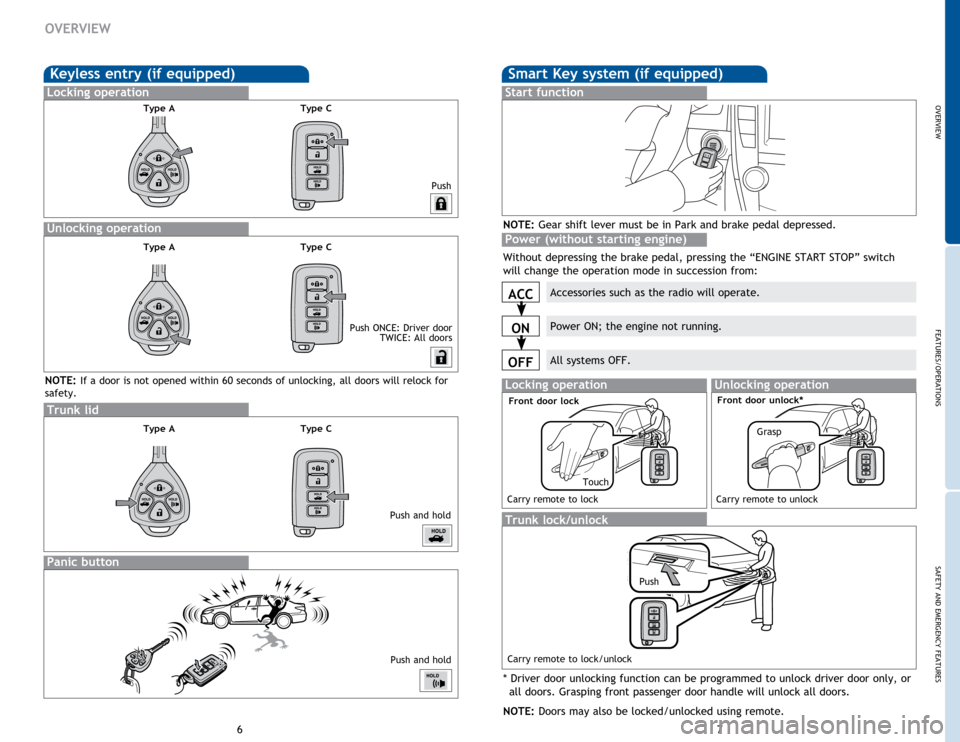
OVERVIEW
FEATURES/OPERATIONS
SAFETY AND EMERGENCY FEATURES
67
OVERVIEW
Keyless entry (if equipped)
Push
Push ONCE: Driver door
TWICE: All doors
Locking operation
Unlocking operation
Type A
Smart Key system (if equipped)
Start function
Accessories such as the radio will operate.
Power ON; the engine not running.
All systems OFF.
ACC
ON
OFF
NOTE: Gear shift lever must be in Park and brake pedal depressed.
Without depressing the brake pedal, pressing the “ENGINE START STOP” switch
will change the operation mode in succession from:
* Driver door unlocking function can be programmed to unlock driver door only, or all doors. Grasping front passenger door handle will unlock all doors.
NOTE: Doors may also be locked/unlocked using remote.
Power (without starting engine)
Panic button
Push and hold
NOTE: If a door is not opened within 60 seconds of unlocking, all doors will relock for
safety.
Trunk lid
Push and holdTrunk lock/unlock
Push
Locking operationUnlocking operation
Carry remote to lock Carry remote to unlock
Front door lock
Carry remote to lock/unlock
Front door unlock*
Type C
Type A
Type A
Type C
Type C
Touch
Grasp
Page 6 of 23
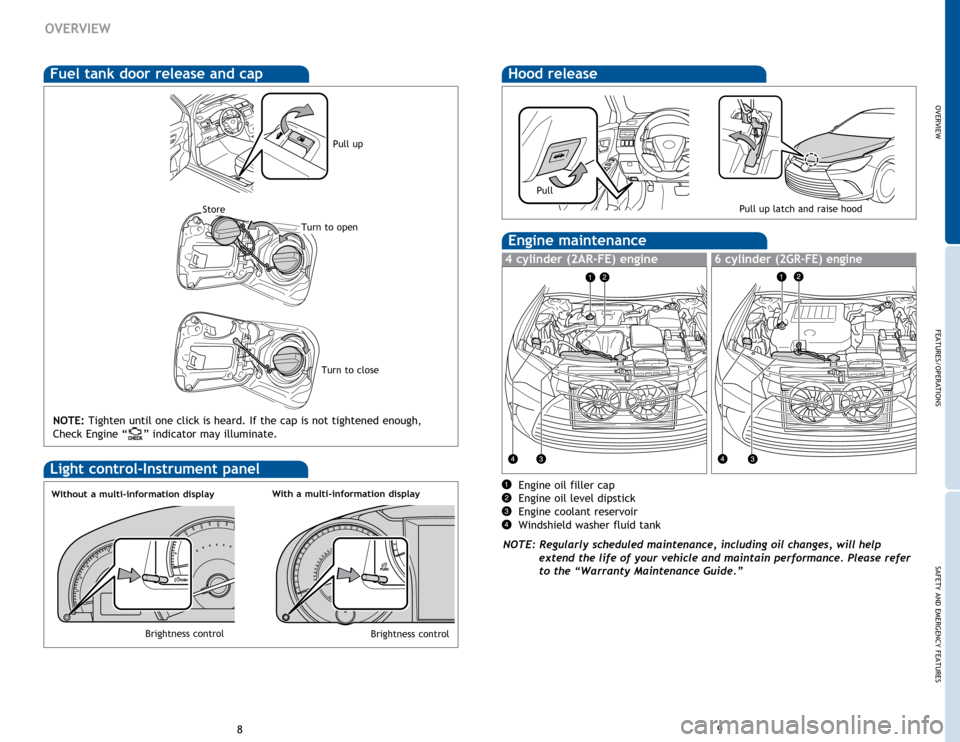
OVERVIEW
FEATURES/OPERATIONS
SAFETY AND EMERGENCY FEATURES
89
Hood release
Pull up latch and raise hood
Pull
Fuel tank door release and cap
NOTE: Tighten until one click is heard. If the cap is not tightened enough,
Check Engine “
” indicator may illuminate.
Pull up
Turn to open
Store
Engine oil filler cap
Engine oil level dipstick
Engine coolant reservoir
Windshield washer fluid tank
NOTE: Regularly scheduled maintenance, including oil changes, will help extend the life of your vehicle and maintain performance. Please refer
to the “Warranty Maintenance Guide.”
Light control-Instrument panel
Brightness control
Engine maintenance
4 cylinder (2AR-FE) engine6 cylinder (2GR-FE) engine
OVERVIEW
Without a multi-information displayWith a multi-information display
Brightness control
Turn to close
Page 7 of 23
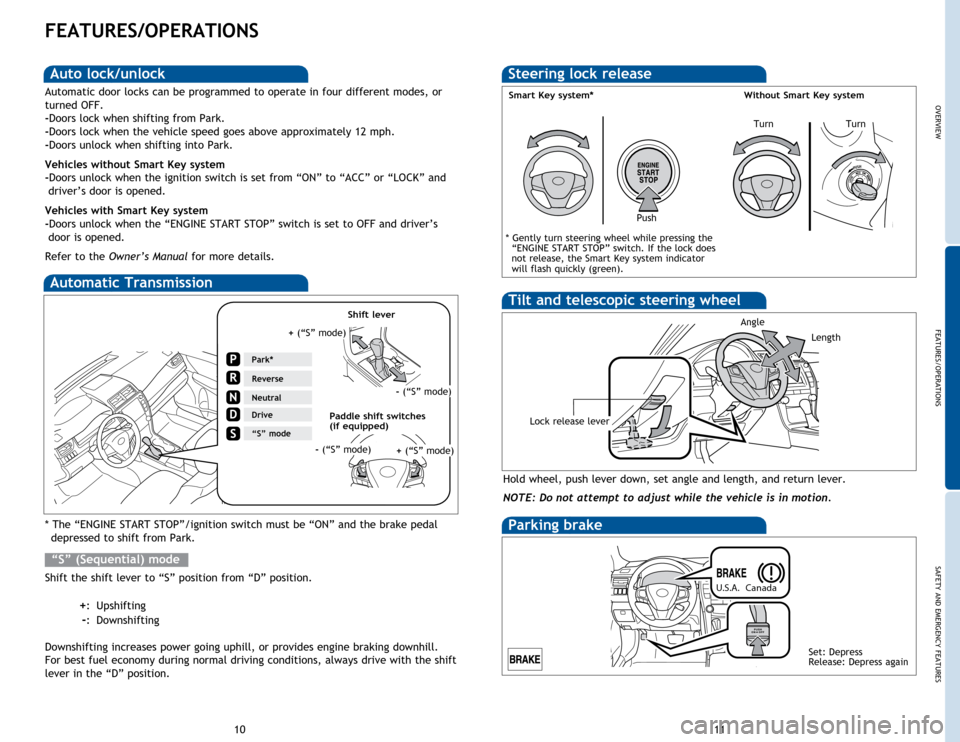
OVERVIEW
FEATURES/OPERATIONS
SAFETY AND EMERGENCY FEATURES
11
10
FEATURES/OPERATIONS
Automatic Transmission
* The “ENGINE START STOP”/ignition switch must be “ON” and the brake pedal
depressed to shift from Park.
Shift the shift lever to “S” position from “D” position.
+: Upshifting
-: Downshifting
Downshifting increases power going uphill, or provides engine braking downhill.
For best fuel economy during normal driving conditions, always drive with the shift
lever in the “D” position.
“S” (Sequential) mode
Steering lock release
Turn
Smart Key system* Without Smart Key system
Push
Turn
Parking brake
Park*
Reverse
Neutral
Drive
N
“S” mode
Auto lock/unlock
Automatic door locks can be programmed to operate in four different modes, or
turned OFF.
-Doors lock when shifting from Park.
-Doors lock when the vehicle speed goes above approximately 12 mph.
-Doors unlock when shifting into Park.
Vehicles without Smart Key system
-Doors unlock when the ignition switch is set from “ON” to “ACC” or “LOCK” and
driver’s door is opened.
Vehicles with Smart Key system
-Doors unlock when the “ENGINE START STOP” switch is set to OFF and driver’s door is opened.
Refer to the Owner’s Manual for more details.
U.S.A. Canada
Set: Depress
Release: Depress again
Hold wheel, push lever down, set angle and length, and return lever.
Lock release lever
NOTE: Do not attempt to adjust while the vehicle is in motion.
Tilt and telescopic steering wheel
* Gently turn steering wheel while pressing the
“ENGINE START STOP” switch. If the lock does
not release, the Smart Key system indicator
will flash
quickly (green).
Angle
Length+ (“S” mode)
- (“S” mode)
+ (“S” mode)- (“S” mode)
Paddle shift switches
(if equipped)Shift lever
Page 9 of 23
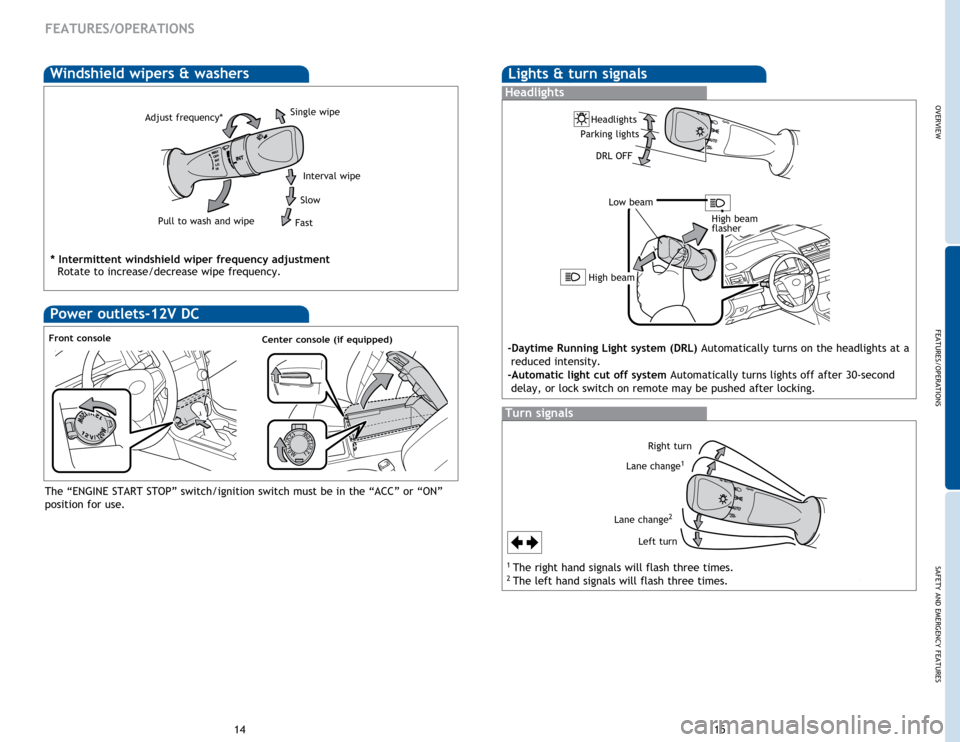
OVERVIEW
FEATURES/OPERATIONS
SAFETY AND EMERGENCY FEATURES
1415
Power outlets-12V DC
Front console
The “ENGINE START STOP” switch/ignition switch must be in the “ACC” or “ON”
position for use.
Center console (if equipped)
Lights & turn signals
Turn signals
Headlights
High beam
-Daytime Running Light system (DRL) Automatically turns on the headlights at a
reduced intensity.
-Automatic light cut off system Automatically turns lights off after 30-second delay, or lock switch on remote may be pushed after locking.
Right turn
Lane change
1
Lane change2
Left turn
High beam
flasher
Windshield wipers & washers
Adjust frequency*
Pull to wash and wipeSingle wipe
Interval wipe
Slow
Fast
FEATURES/OPERATIONS
* Intermittent windshield wiper frequency adjustment
Rotate to increase/decrease wipe frequency.
Headlights
Parking lights
DRL OFF
Low beam
1 The right hand signals will flash three times.2 The left hand signals will flash three times.
Page 16 of 23
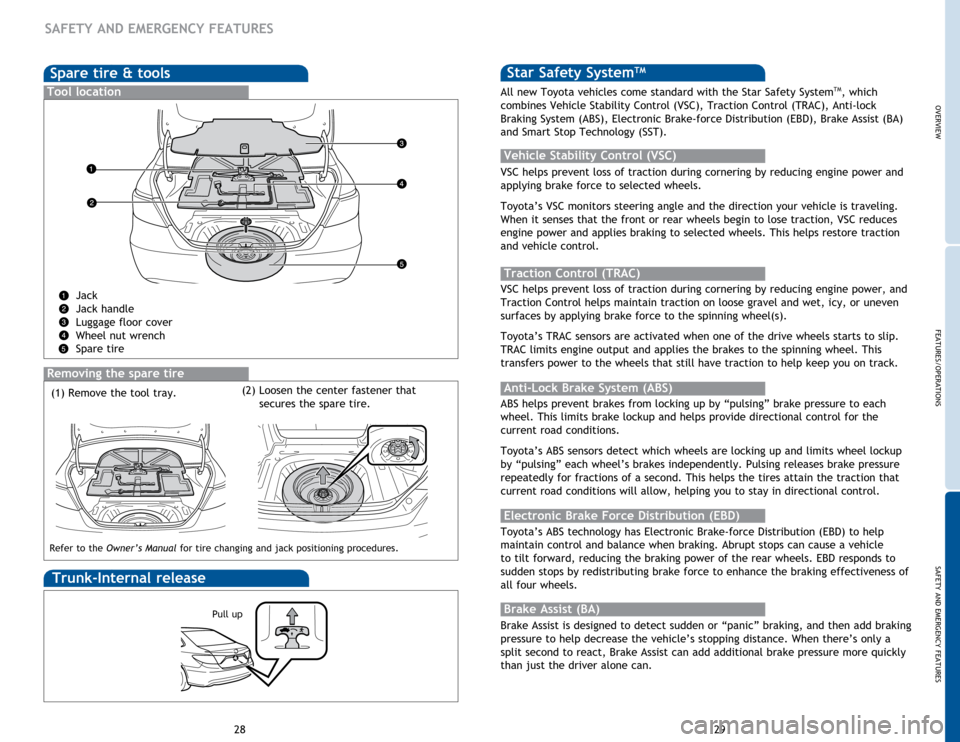
OVERVIEW
FEATURES/OPERATIONS
SAFETY AND EMERGENCY FEATURES
29
28
Star Safety SystemTM
VSC helps prevent loss of traction during cornering by reducing engine power and
applying brake force to selected wheels.
Toyota’s VSC monitors steering angle and the direction your vehicle is traveling.
When it senses that the front or rear wheels begin to lose traction, VSC reduces
engine power and applies braking to selected wheels. This helps restore traction
and vehicle control.
Vehicle Stability Control (VSC)
Anti-Lock Brake System (ABS)
ABS helps prevent brakes from locking up by “pulsing” brake pressure to each
wheel. This limits brake lockup and helps provide directional control for the
current road conditions.
Toyota’s ABS sensors detect which wheels are locking up and limits wheel lockup
by “pulsing” each wheel’s brakes independently. Pulsing releases brake pressure
repeatedly for fractions of a second. This helps the tires attain the traction that
current road conditions will allow, helping you to stay in directional control.
Brake Assist (BA)
Brake Assist is designed to detect sudden or “panic” braking, and then add braking
pressure to help decrease the vehicle’s stopping distance. When there’s only a
split second to react, Brake Assist can add additional brake pressure more quickly
than just the driver alone can. VSC helps prevent loss of traction during cornering by reducing engine power, and
Traction Control helps maintain traction on loose gravel and wet, icy, or uneven
surfaces by applying brake force to the spinning wheel(s).
Toyota’s TRAC sensors are activated when one of the drive wheels starts to slip.
TRAC limits engine output and applies the brakes to the spinning wheel. This
transfers power to the wheels that still have traction to help keep you on track.
Traction Control (TRAC)
Electronic Brake Force Distribution (EBD)
Toyota’s ABS technology has Electronic Brake-force Distribution (EBD) to help
maintain control and balance when braking. Abrupt stops can cause a vehicle
to tilt forward, reducing the braking power of the rear wheels. EBD responds to
sudden stops by redistributing brake force to enhance the braking effectiveness of
all four wheels.
SAFETY AND EMERGENCY FEATURES
All new Toyota vehicles come standard with the Star Safety SystemTM, which
combines Vehicle Stability Control (VSC), Traction Control (TRAC), Anti-lock
Braking System (ABS), Electronic Brake-force Distribution (EBD), Brake Assist (BA)
and Smart Stop Technology (SST).
Spare tire & tools
Tool location
Jack
Jack handle
Luggage floor cover
Wheel nut wrench
Spare tire
Removing the spare tire
(1) Remove the tool tray.
Trunk-Internal release
Pull up
Refer to the
Owner’s Manual for tire changing and jack positioning procedures.
(2) Loosen the center fastener that
secures the spare tire.